Ford Transit Transporter VS Hyundai Santa Fe – Specs, Efficiency & Price Comparison
Which model is the better choice – the Ford Transit Transporter or the Hyundai Santa Fe? We compare performance (269 HP vs 253 HP), boot capacity ( vs 711 L), efficiency (21.30 kWh7.90 L vs 1.70 L), and of course, the price (39900 £ vs 48600 £).
Find out now which car fits your needs better!
The Ford Transit Transporter (Cargo Van) is powered by a Diesel or Electric engine and comes with a Manuel or Automatic transmission. In comparison, the Hyundai Santa Fe (SUV) features a Full Hybrid or Plugin Hybrid engine and a Automatic gearbox.
When it comes to boot capacity, the Ford Transit Transporter offers , while the Hyundai Santa Fe provides 711 L – depending on what matters most to you. If you’re looking for more power, you’ll need to decide whether the 269 HP of the Ford Transit Transporter or the 253 HP of the Hyundai Santa Fe suits your needs better.
There are also differences in efficiency: 21.30 kWh7.90 L vs 1.70 L. In terms of price, the Ford Transit Transporter starts at 39900 £, while the Hyundai Santa Fe is available from 48600 £.
Compare all the key specs now and find out which model fits your lifestyle best!
Ford Transit Transporter
The Ford Transit Transporter has long been a staple in the commercial vehicle sector, renowned for its reliability and versatility. It offers a comfortable cabin with a modern design that enhances the driving experience, making long journeys more enjoyable. With a focus on practicality, the Transit provides ample cargo space, meeting the demands of businesses and individual users alike.
details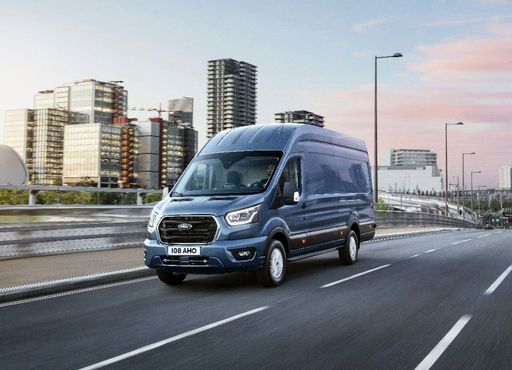 @ media.ford.com
@ media.ford.com
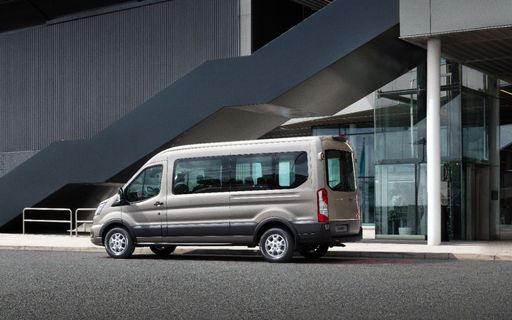 @ media.ford.com
@ media.ford.com
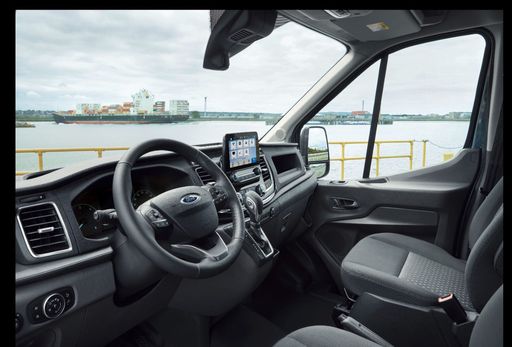 @ media.ford.com
@ media.ford.com
Hyundai Santa Fe
The Hyundai Santa Fe offers a refined blend of style and functionality, making it a strong contender in the SUV market. Its modern interior, combined with advanced technology and comfort features, creates an inviting and practical driving environment. With its sleek design and robust performance, the Santa Fe is well-suited for both urban commutes and family adventures.
details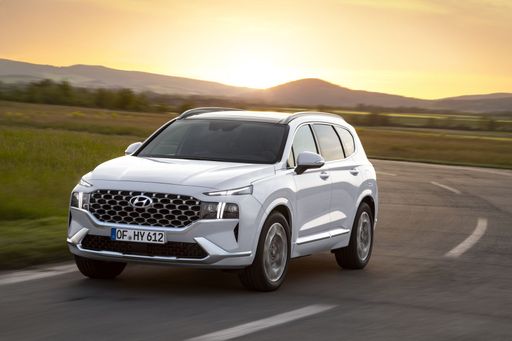 @ hyundai.news
@ hyundai.news
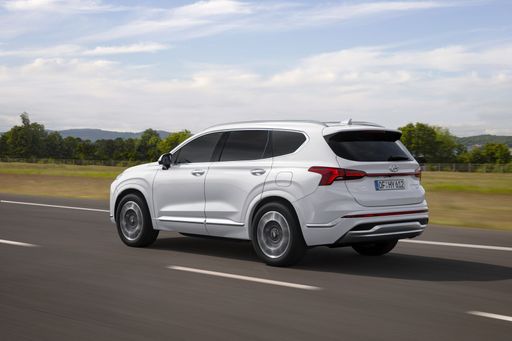 @ hyundai.news
@ hyundai.news
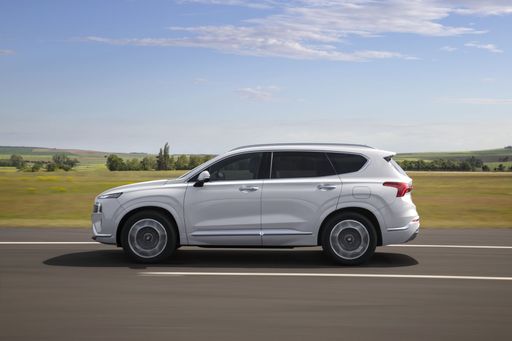 @ hyundai.news
@ hyundai.news
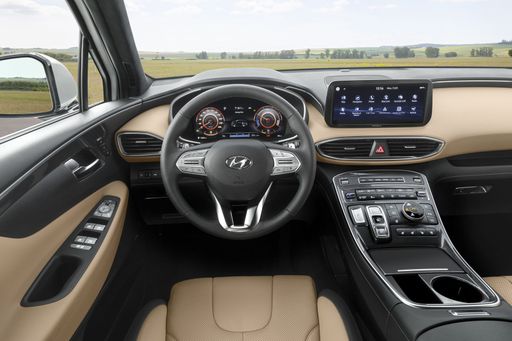 @ hyundai.news
@ hyundai.news
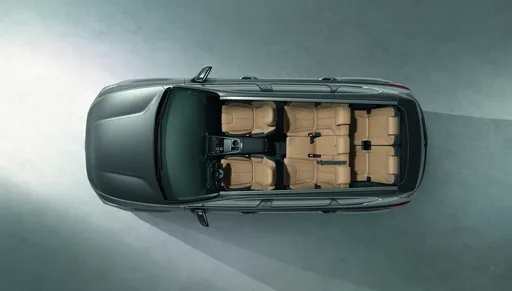 @ hyundai.news
@ hyundai.news

|

|
|
|
|
Costs and Consumption |
|
|---|---|
|
Price
39900 - 69100 £
|
Price
48600 - 58400 £
|
|
Consumption L/100km
7.9 - 10.3 L
|
Consumption L/100km
1.7 - 6.9 L
|
|
Consumption kWh/100km
21.3 - 32 kWh
|
Consumption kWh/100km
-
|
|
Electric Range
247 - 317 km
|
Electric Range
54 km
|
|
Battery Capacity
68 kWh
|
Battery Capacity
-
|
|
co2
0 - 270 g/km
|
co2
38 - 167 g/km
|
|
Fuel tank capacity
70 L
|
Fuel tank capacity
67 L
|
Dimensions and Body |
|
|---|---|
|
Body Type
Cargo Van
|
Body Type
SUV
|
|
Seats
3 - 6
|
Seats
5 - 7
|
|
Doors
4
|
Doors
5
|
|
Curb weight
2074 - 2765 kg
|
Curb weight
1920 - 2165 kg
|
|
Trunk capacity
-
|
Trunk capacity
621 - 711 L
|
|
Length
5531 - 6704 mm
|
Length
4830 mm
|
|
Width
2059 mm
|
Width
1900 mm
|
|
Height
2530 - 2778 mm
|
Height
1720 mm
|
|
Payload
735 - 2607 kg
|
Payload
560 - 665 kg
|
Engine and Performance |
|
|---|---|
|
Engine Type
Diesel, Electric
|
Engine Type
Full Hybrid, Plugin Hybrid
|
|
Transmission
Manuel, Automatic
|
Transmission
Automatic
|
|
Transmission Detail
Manual Gearbox, Automatic Gearbox, Reduction Gearbox
|
Transmission Detail
Automatic Gearbox
|
|
Drive Type
Front-Wheel Drive, Rear-Wheel Drive, All-Wheel Drive
|
Drive Type
Front-Wheel Drive, All-Wheel Drive
|
|
Power HP
105 - 269 HP
|
Power HP
215 - 253 HP
|
|
Acceleration 0-100km/h
-
|
Acceleration 0-100km/h
9.3 - 9.8 s
|
|
Max Speed
120 km/h
|
Max Speed
180 km/h
|
|
Torque
310 - 430 Nm
|
Torque
367 Nm
|
|
Number of Cylinders
4
|
Number of Cylinders
4
|
|
Power kW
77 - 198 kW
|
Power kW
158 - 186 kW
|
|
Engine capacity
1995 cm3
|
Engine capacity
1598 cm3
|
General |
|
|---|---|
|
Model Year
2019 - 2024
|
Model Year
2024
|
|
CO2 Efficiency Class
G, A
|
CO2 Efficiency Class
E, F, B
|
|
Brand
Ford
|
Brand
Hyundai
|
Ford Transit Transporter
Discovering the Ford Transit Transporter: A Blend of Tradition and Innovation
The Ford Transit Transporter has long been a staple in the commercial vehicle market, known for its reliability and versatility. As Ford continues its innovative journey, the Transit Transporter integrates modern technology and eco-friendly advancements, making it more appealing than ever. Here, we explore some of its key technical details and innovations.
Under the Bonnet: Engine Variants and Efficiency
The Ford Transit Transporter offers a variety of engine options to cater to diverse commercial needs. Among these, the 2.0 EcoBlue Diesel engine provides a robust selection of power outputs, ranging from 105 to 165 PS. Not just limited to traditional fuel, Ford also introduces the E-Transit line with electric motors generating up to 269 PS. This transition to electric is an essential step towards sustainability, achieving an impressive range of 247 to 317 km on a full charge.
Fuel Economy and Environmental Impact
When it comes to fuel efficiency, the Transit Transporter presents a competitive edge with diesel variants consuming between 7.9 to 10.3 L/100km. On the electric side, consumption levels are measured at 21.3 to 32 kWh/100km. Furthermore, the Transit’s CO2 emissions range from zero for electric models to 270 g/km for select diesel engines, placing the vehicle in varying CO2 efficiency classes from G to A.
Performance and Driving Dynamics
Designed for optimal performance, the vehicle’s torque output ranges from 310 to 430 Nm, facilitating smooth and powerful driving experiences across various terrains. The Transit Transporter boasts a maximum speed of 120 km/h, ensuring timely commutes and deliveries, crucial for business efficacy.
The Versatility of Drivetrain Options
The Ford Transit Transporter provides an array of drivetrain configurations, including front-wheel, rear-wheel and all-wheel drive. This adaptability enables the vehicle to tackle different driving conditions with ease, offering stability and resilience no matter the challenge.
Technology and Innovation on Board
Ford’s commitment to innovation is evident within the Transit Transporter’s interior. Intuitive features such as advanced driver-assistance systems, smart connectivity tools, and ergonomic seating arrangements ensure that both driver and passengers enjoy a seamless and comfortable journey, ideal for long rides or daily routines.
Crafted for Practicality and Comfort
With length variations extending from 5531 mm to 6704 mm, and height options from 2530 mm to 2778 mm, the Ford Transit Transporter offers expansive cargo space and flexible seating arrangements. Depending on the variant, seating options range from 3 to 6 seats, catering to diverse passenger and cargo needs.
A Future-Ready, Cost-Effective Choice
Price tags for the Ford Transit Transporter range from €46,589 to €80,611, accommodating different budget requirements. With monthly operation costs calculated between €1430 and €1991, the Transit remains a financially viable option for businesses seeking reliability and efficiency.
Conclusion: An Unyielding Commitment to Excellence
The Ford Transit Transporter stands as a testament to Ford’s dedication to marrying tradition with progress. With its diverse range of powertrains, technological integrations, and practical design, it continues to lead the commercial vehicle segment, ready to meet the challenges of modern mobility and sustainability.
Hyundai Santa Fe
Discover the All-New Hyundai Santa Fe: A Blend of Performance and Innovation
The 2024 Hyundai Santa Fe is not just a step forward in technology; it's a leap. Combining style with substance, this SUV brings cutting-edge features to the road, promising exceptional performance and enhanced efficiency. Let's explore the new offerings of this impressive vehicle.
Powertrain and Efficiency Explained
The Hyundai Santa Fe is available with advanced hybrid and plug-in hybrid engines, offering an environmentally conscious approach without compromising on power. The hybrid variant, featuring a 1.6 T-GDI engine, delivers a respectable 215 PS, whereas the plug-in hybrid tops the range with 253 PS. Both options pair seamlessly with an automatic transmission, ensuring a smooth and efficient drive.
Fuel consumption has also been a focus, with the hybrid achieving rates as low as 6.4 L/100km, and the plug-in hybrid boasting an impressively low 1.7 L/100km. The latter also offers an all-electric range of up to 54 km, making it a practical choice for city driving.
Advanced Driving Experience
Hyundai has placed a strong emphasis on creating an engaging driving experience. With a maximum torque of 367 Nm, acceleration from 0-100 km/h is achieved in just under 10 seconds, providing a responsive and lively performance on all terrains. Front-wheel and all-wheel drive options ensure you have the flexibility to choose the setup that best suits your driving style.
Next-Level Safety and Convenience Features
The Santa Fe is packed with a suite of safety features designed to provide peace of mind. Hyundai's SmartSense technology includes forward collision warning, blind-spot monitoring, and a rear cross-traffic alert. These innovations ensure that every journey is as safe as it is enjoyable.
Convenience is not overlooked either, with a spacious interior offering seating configurations from 5 to 7 seats. The boot space ranges from 621 to 711 litres, making it ideal for family trips and those with an active lifestyle. The advanced infotainment system keeps you connected on the go, ensuring you have everything you need at your fingertips.
Stylish Design and Comfort
The Hyundai Santa Fe's refined design combines robust SUV aesthetics with modern elegance. Its dimensions — 4830 mm in length, 1900 mm in width, and 1720 mm in height — provide a commanding presence on the road. Premium material finishes and high-quality upholstery add to the luxurious feel of the cabin.
Unmatched Value for Money
With prices ranging from €56,700 to €68,150, the Santa Fe represents substantial value for the range of technology and luxury offered. Monthly running costs and efficiency also mean that the Hyundai Santa Fe provides long-term savings for the discerning consumer.
Suitable for any lifestyle, the new Hyundai Santa Fe is poised to capture the attention of SUV enthusiasts, combining performance, safety, and cutting-edge technology in a beautifully crafted package.
The prices and data displayed are estimates based on German list prices and may vary by country. This information is not legally binding.
